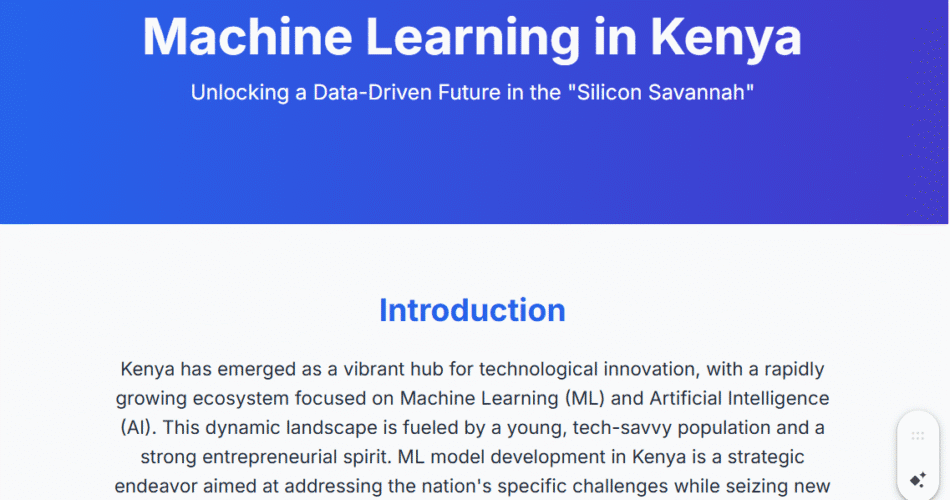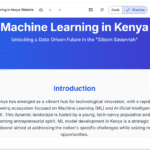Machine Learning Model Development Kenya:
-
Delivery Time2 Weeks
-
English levelProfessional
-
LocationUSA, United Kingdom, United Arab Emirates, Nairobi, Kilimani, Kenya, Dubai, CBD Nairobi, Canada, Australia
Service Description
The cost of machine learning model Development in kenya is 900000KES.Get machine learning model Development in kenya at a price of 800000KES at Black Shepherd Technologies.
Explore the cutting-edge of Machine Learning model development in Kenya. From ideation to deployment, discover how local experts are leveraging ML to solve unique challenges, drive innovation, and create a data-driven future for East Africa.
In recent years, Kenya has emerged as a vibrant hub for technological innovation, with a rapidly growing ecosystem focused on Machine Learning (ML) and Artificial Intelligence (AI). This dynamic landscape is fueled by a combination of factors: a young, tech-savvy population, a strong entrepreneurial spirit, and an increasing recognition of the power of data. Machine Learning model development in Kenya is not merely a technical exercise; it’s a strategic endeavor aimed at addressing the nation’s specific economic and social challenges while seizing new opportunities.
The journey of developing an ML model in Kenya typically begins with problem identification. Unlike Silicon Valley, where problems might be abstract, Kenyan developers often tackle tangible, local issues. This includes building predictive models for agricultural yields to enhance food security, creating AI-driven financial tools to improve access to credit for small businesses, or developing natural language processing (NLP) models to better understand local languages and dialects. The data used for these models is often unique, requiring creative approaches to collection, cleaning, and preprocessing. Developers frequently deal with unstructured or sparse data, which demands a deep understanding of data engineering and feature extraction.
The development lifecycle follows a familiar, yet uniquely adapted, path. After defining the problem and gathering data, the process moves to model selection. Kenyan ML engineers are proficient in a wide range of algorithms, from classic supervised learning methods like linear regression and decision trees to more complex deep learning architectures. The choice of model is often influenced by computational constraints. While access to cloud computing resources like AWS, Google Cloud, and Azure is growing, some projects require models that can run efficiently on lower-spec hardware, such as mobile phones, due to the prevalence of mobile-first access in the country. This necessitates a focus on model optimization and compression techniques.
Training and validation are crucial stages. Local datasets, often with unique biases, require careful handling to ensure the models are fair and accurate. Bias detection and mitigation are key ethical considerations, especially when models are used for sensitive applications like credit scoring or resource allocation. The validation phase involves rigorous testing against real-world data, often in pilot programs with local communities or businesses, ensuring that the model’s predictions are reliable and useful in the intended context.
Deployment is a critical step where the model transitions from a proof of concept to a functional tool. This can involve integrating the model into a web application, a mobile app, or an existing business system. The deployment strategy is often influenced by the target user. For agricultural apps, a user-friendly mobile interface is essential. For financial services, seamless integration with existing banking platforms is paramount. Post-deployment, continuous monitoring and maintenance are vital. Models can degrade over time as data distributions change, a phenomenon known as “data drift.” Kenyan ML practitioners must set up robust monitoring systems to retrain models and ensure they remain effective.
The ML ecosystem in Kenya is supported by a growing number of institutions and initiatives. Universities are launching specialized programs in data science and AI. Tech incubators and accelerators are providing mentorship and funding to promising startups. Hackathons and meetups organized by communities like the Google Developer Groups (GDG) and local AI forums foster collaboration and knowledge sharing. This collaborative environment ensures that developers are constantly learning and adapting to the latest advancements in the field.
Looking ahead, the future of Machine Learning model development in Kenya is exceptionally bright. The country is poised to lead in applications that leverage its unique strengths, such as mobile data, agricultural insights, and a young, dynamic workforce. By focusing on practical, problem-solving applications, Kenyan ML experts are not just developing models; they are building a data-driven future that is inclusive, innovative, and deeply rooted in the needs of their community.Training and validation are crucial stages. Local datasets, often with unique biases, require careful handling to ensure the models are fair and accurate. Bias detection and mitigation are key ethical considerations, especially when models are used for sensitive applications like credit scoring or resource allocation. The validation phase involves rigorous testing against real-world data, often in pilot programs with local communities or businesses, ensuring that the model’s predictions are reliable and useful in the intended context.
Deployment is a critical step where the model transitions from a proof of concept to a functional tool. This can involve integrating the model into a web application, a mobile app, or an existing business system. The deployment strategy is often influenced by the target user. For agricultural apps, a user-friendly mobile interface is essential. For financial services, seamless integration with existing banking platforms is paramount. Post-deployment, continuous monitoring and maintenance are vital. Models can degrade over time as data distributions change, a phenomenon known as “data drift.” Kenyan ML practitioners must set up robust monitoring systems to retrain models and ensure they remain effective.
The ML ecosystem in Kenya is supported by a growing number of institutions and initiatives. Universities are launching specialized programs in data science and AI. Tech incubators and accelerators are providing mentorship and funding to promising startups. Hackathons and meetups organized by communities like the Google Developer Groups (GDG) and local AI forums foster collaboration and knowledge sharing. This collaborative environment ensures that developers are constantly learning and adapting to the latest advancements in the field.
Key Trends and Success Stories
The practical application of ML in Kenya is visible across various sectors, demonstrating its potential for real-world impact. In agriculture, a vital pillar of the economy, models are being developed to predict crop diseases and optimize yields, like the “Third Eye” project which uses drones for monitoring. In healthcare, an AI model has been developed to provide an early warning for acute child malnutrition by integrating clinical and satellite data, achieving impressive predictive accuracy.
Another noteworthy trend is the rise of AI-powered financial solutions for the unbanked and underbanked. Platforms are using ML to assess creditworthiness based on alternative data sources, such as mobile phone usage and payment history, extending financial inclusion to a broader segment of the population. Furthermore, developers are creating chatbots in local languages like Kiswahili to make technology more accessible, as seen with Safaricom’s Zuri chatbot.
Challenges and the Path Forward
Despite the rapid progress, the Kenyan ML landscape faces significant challenges. The lack of high-quality, relevant local datasets is a major hurdle. Many models are trained on data from different contexts, which can lead to biases and reduced effectiveness. Additionally, there is a need for a more comprehensive legal and ethical framework to govern the use of AI. While the Data Protection Act is a start, a dedicated AI law is crucial to address issues of algorithmic bias, accountability, and intellectual property.
The digital divide also remains a concern. While mobile penetration is high, reliable broadband access in rural areas is limited, which can create a gap in who benefits from AI solutions. There’s also a need to bridge the skills gap through more targeted education and training programs that go beyond basic digital literacy to include advanced AI skills.
Conclusion
The development of Machine Learning models in Kenya is a testament to the nation’s ingenuity and its commitment to leveraging technology for social and economic good. It is a story of local innovation, where solutions are not just imported but are built from the ground up to solve specific, contextual problems. The future of ML in Kenya is not just about building smarter algorithms; it’s about building a smarter, more inclusive, and more resilient society. By continuing to invest in human capital, fostering a collaborative ecosystem, and establishing clear ethical guidelines, Kenya is well on its way to cementing its position as a leader in the African tech landscape, and a model for how emerging economies can harness the power of AI to create a brighter future for all.








